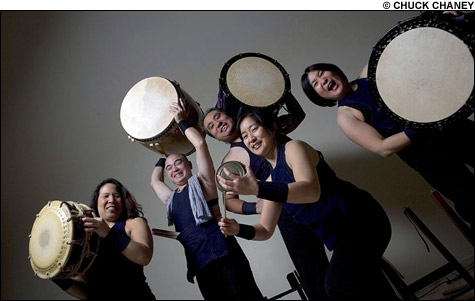
POUND FOR POUND "You can't not think about how it takes every inch of your body to hit the drum," says ONE director Mark Rooney. |
A single set of precise, thundering beats fills the modest rehearsal space of Woburn's American Chinese Art Society. The sound rattles the flooring and shakes my guts. It emanates from a petite woman holding two thick wooden sticks and walloping a pair of hip-high, double-headed wooden drums. The Odaiko New England (ONE) drummers are rehearsing here, and as five more members begin striking, the sound swells into an orchestral heartbeat, a massive, unified sonic whole.
"Taiko is one of the loudest forms of percussion in the world, so it's something you register all over your body," says ONE's artistic director, Mark Rooney. "It's something you feel, and people can feel the energy that comes from it." In 1994, veteran taiko drummer Elaine Fong started the group to bring people together to enjoy this traditional form of Japanese drumming, which has been around for more than 1000 years. These days ONE performs about 100 times a year; it also spearheads teaching programs throughout New England. Rooney's goal as director has been to maintain the historical integrity of traditional taiko while also modernizing it. ReVision, the group's 15th-anniversary performance at Regent Theatre this weekend, is the culmination of his objective. "This is a launching of a new vision," Rooney explains. "It's a way of rethinking not just how we present ourselves on a stage but how we approach and practice taiko."
Taiko has enjoyed a recent surge of popularity in the US, thanks to flashy commercials and glitzy music videos for the likes of Mitsubishi, Kanye West, and the Academy Awards. Collegiate drumming groups are spreading across the country like swine flu (still spreading, right?). ONE even performed the National Anthem at one of last summer's Sox-Yankees games as a tribute to Daisuke Matsuzaka. (Sox won.) There are more than 200 taiko groups in America, and between 5000 and 10,000 in Japan.
Rooney incorporates his 21st-century updates in several ways. Drumming used to accompany dances, theater performances, and special ceremonies, and usually only one or two people took part. Playing in a group of five or more, as ONE does, is a relatively new practice. Rooney also writes most of the string and vocal parts for their songs.
"As an American taiko drummer, I feel a lot of freedom to compose, to combine, to collaborate with other artists. And certainly most anyone who's heard any of the songs I've written will tell you that I definitely have a rock-and-roll influence." Rooney explains how he took the guitar riff from Soundgarden's "Spoonman" and broke it down into drum beats that can be played on taiko drums, beatboxing them to me in a "jugga-ja-ja" series.
In addition to a subtle rock infusion, ReVision will include a couple of local musicians: violinist Yael Bat-Shimon and cellist and singer (he's also Roxbury Community College's Media Arts Center director) Marshall Hughes. Beth Lowe and David Wiggins, both ONE members, will add vocals and strings. The accompaniment supplies an orchestral frailty — a sense of yin to the dominant yang of the drums. And dancer Abby Kazlouski, a teacher at the Sarah Greenwood School, will create her own choreography to complement the music.